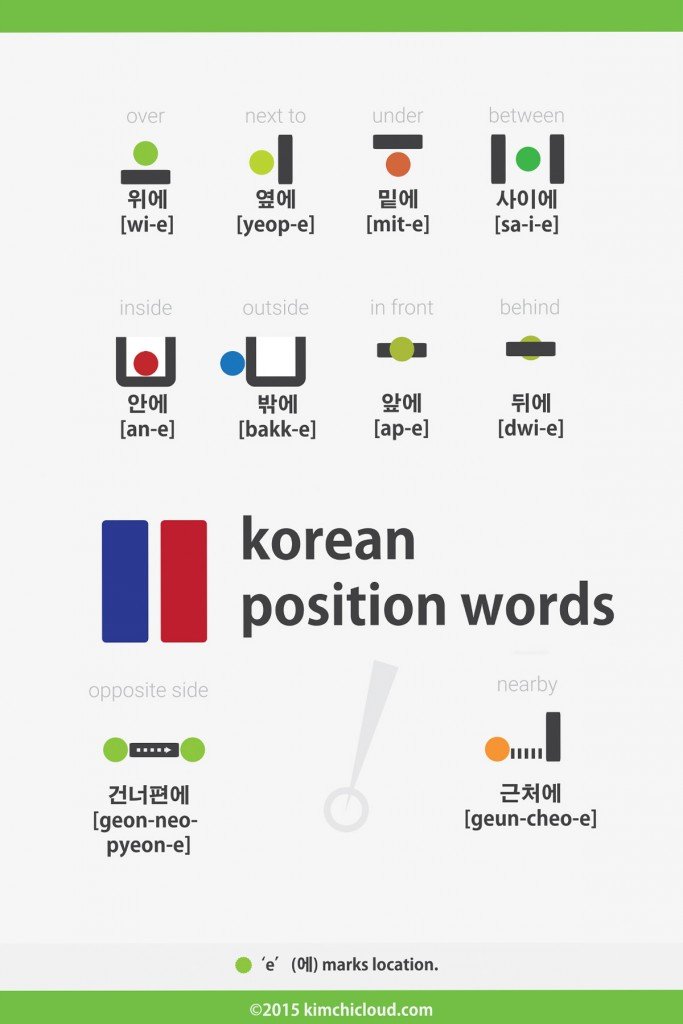Korean Position Words / Prepositions
Korean Position Words
First of all, what are prepositions? Well, they are those little words that serve as links between words or describe relationships based on time or space that seemingly have as many rules as exceptions. Prepositions as we are used to in English don’t translate all that well to Korean and words like ‘through’ can have many different translations.
So to make it easier, we can group similar words together and in this lesson we will concentrate on the words that describe position (under, over, inside, outside etc.)
To mark a position or location in Korean, you use the 에 (e) particle ( which also has other usages). This particle works well in conjunction with these position words and is usually memorized together. You can separate the particle from the words if you want but I wouldn’t recommend doing so. It won’t do any harm, but on the flipside, learning them together might help fluency.
| English | Korean |
|---|---|
| Over / On | 위에 [wi-e] |
| Under | 밑에 / 아래에 [mit-e / a-rae-e] |
| Next to | 옆에 [yeop-e] |
| Between | 사이에 [sa-i-e] |
| Inside | 안에 [an-e] |
| Outside | 밖에 [bakk-e] |
| In front | 앞에 [ap-e] |
| Behind | 뒤에 [dwi-e] |
| Opposite side | 건너편에 / 맞은편에 / 반대편에 [geon-neo-peyon-e / ma-jeun-pyeon-e / ban-dae-pyeon-e] |
| Nearby | 근처에 [geun-cheo-e] |
Practical use of position words
To make more use of these words, we can pair them up with a noun, like ‘school.’ So if we wanted to say ‘in front of school’ we would say:
학교 앞에
[hak-kyo ap-e]
= in front of school.
But let’s try to make a little longer sentence than that:
공책이 책상 위에 있어요.
[kong-chaek-i chaek-sang wi-e isseo-yo]
= The note book is on top of the desk.
To ask where someone or something is, you use the question word 어디 [eo-di] meaning ‘where.’ :
어디에 있어요?
[eo-di-e isseo-yo?]
= Where is it? Where are you?
So to ask where the school is, we would say:
학교가 어디에 있어요?
[hak-kyo-ga eo-di-e isseo-yo]
= Where is the school?
To answer, we could say:
병원 옆에 있어요
[byeon-won yeop-e isseo-yo]
= It’s in front of the hospital.
Different particle for actions
While grammar is not the focus on this lesson, note that, if you are describing where an action (playing, eating, meeting etc.) takes place and not where something is located, you need to switch particles from 에 [e] to 에서 [e-seo]. For example:
학교 앞에 -> 학교 앞에서
[hak-kyo ap-e -> hak-kyo ap-e-seo]
And of course a full sentence.
학교 앞에서 만날 거예요
[hak-kyo ap-e-seo man-nal-keo-ye-yo]
= I will meet them in front of the school.
For more lessons like this, check out our Everyday Korean section and our articles on Korean grammar.
And if you found this useful, please like or share! If you have any questions or something else you want to say, make sure to let us know by posting a comment below and we will do our best to help you out!
By: Kimchi Cloud





